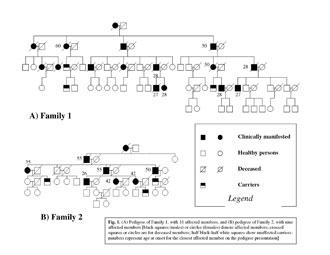


DIFFERENT AGE AT ONSET IN TWO PEDIGREES
WITH SPINOCEREBELLAR ATAXIA TYPE 1 (SCA1)
FROM THE SAME VILLAGE WITH SIMILAR LENGTH
OF CAG EXPANSIONS IN THE SCA1 GENE
Svetel M1, Culjkovic B2, Stojkovic O2, Dragasevic N1, Stefanova E1,
Romac S2, Kostic VS1
*Corresponding Author: Professor Vladimir S. Kostic, Institute of Neurology Clinical Center of Serbia, ul. Dr. Subotica 6, 11000 Belgrade, Yugoslavia; Tel: +381-11-685-554; Fax: +381-11-684-577; E-mail: kostic@ imi.bg.ac.yu
page: 7
|
|
DISCUSSION
We have described two families originating from the same village, with a large number of affected members diagnosed as SCA1, who were strikingly different in the age at onset (mean age at onset 31.8 years for Family 1 versus 45.4 years in Family 2; p<0.01). Analysis of the D6S337 haplotypes in SCA1-affected patients, suggests that SCA1 expansions in these two families are not from the same origin. Overall, the reported mean age at onset has varied in different studies from 26 to 44.3 years, with a wide range of values frequently seen in the same family [2]. Ranum et al. [7] suggested that there was some intrafamilial clustering in the age of onset, with some families having mainly later, others having earlier onset (like Family 1), and still others with a wide range in age at onset.
Several groups found an inverse correlation between the age at onset and the number of CAG repeats on the expanded allele [8,9]. Ranum et al. [7] found that repeat size accounted for 66% of the variation in age at onset, suggesting that additional genetic factors affect the expression of the disease.
Although we tested a limited number of patients in both families, no substantial difference in the mean number of CAG repeats in the mutated allele between the two families was observed, despite the significant difference in the age at onset. It has been suggested that the number of CAG repeats on the normal allele might affect the age at onset in Huntington’s disease [10]. Again, even if we speculate a similar possibility in SCA1, no difference was observed in the mean number of CAG repeats on the normal alleles of affected persons in these two families. The relationship between anticipation and the number of CAG repeats in successive generations was not ascertainable, as well as the possible tendency to paternal bias for accelerated age at onset, previously reported in SCA1 [11]. However, this appears to be unlikely, since the paternal transmission was even more common in Family 2, with later onset of SCA1 (Fig. 1a and 1b).
Environmental factors could also account for clinical variations, including age at onset, in SCA1. However, these two families share very similar environmental conditions since their properties are 150 m apart. All studied members of these two families were farmers and were involved in animal husbandry as well. Thus, they used similar or identical working methods and shared the same local dietary habits and all drank well water. We were unable to identify any specific feature in the environmental conditions that would differentiate these two families.
In conclusion, similarity of the length of CAG repeat expansions in the ataxin-1 gene in these two unrelated families, as well as the similarity of environmental factors, suggest that some other, unknown genetic factor(s) could contribute to the variability of the age at onset of SCA1.

|
|
|
|



 |
Number 27
VOL. 27 (2), 2024 |
Number 27
VOL. 27 (1), 2024 |
Number 26
Number 26 VOL. 26(2), 2023 All in one |
Number 26
VOL. 26(2), 2023 |
Number 26
VOL. 26, 2023 Supplement |
Number 26
VOL. 26(1), 2023 |
Number 25
VOL. 25(2), 2022 |
Number 25
VOL. 25 (1), 2022 |
Number 24
VOL. 24(2), 2021 |
Number 24
VOL. 24(1), 2021 |
Number 23
VOL. 23(2), 2020 |
Number 22
VOL. 22(2), 2019 |
Number 22
VOL. 22(1), 2019 |
Number 22
VOL. 22, 2019 Supplement |
Number 21
VOL. 21(2), 2018 |
Number 21
VOL. 21 (1), 2018 |
Number 21
VOL. 21, 2018 Supplement |
Number 20
VOL. 20 (2), 2017 |
Number 20
VOL. 20 (1), 2017 |
Number 19
VOL. 19 (2), 2016 |
Number 19
VOL. 19 (1), 2016 |
Number 18
VOL. 18 (2), 2015 |
Number 18
VOL. 18 (1), 2015 |
Number 17
VOL. 17 (2), 2014 |
Number 17
VOL. 17 (1), 2014 |
Number 16
VOL. 16 (2), 2013 |
Number 16
VOL. 16 (1), 2013 |
Number 15
VOL. 15 (2), 2012 |
Number 15
VOL. 15, 2012 Supplement |
Number 15
Vol. 15 (1), 2012 |
Number 14
14 - Vol. 14 (2), 2011 |
Number 14
The 9th Balkan Congress of Medical Genetics |
Number 14
14 - Vol. 14 (1), 2011 |
Number 13
Vol. 13 (2), 2010 |
Number 13
Vol.13 (1), 2010 |
Number 12
Vol.12 (2), 2009 |
Number 12
Vol.12 (1), 2009 |
Number 11
Vol.11 (2),2008 |
Number 11
Vol.11 (1),2008 |
Number 10
Vol.10 (2), 2007 |
Number 10
10 (1),2007 |
Number 9
1&2, 2006 |
Number 9
3&4, 2006 |
Number 8
1&2, 2005 |
Number 8
3&4, 2004 |
Number 7
1&2, 2004 |
Number 6
3&4, 2003 |
Number 6
1&2, 2003 |
Number 5
3&4, 2002 |
Number 5
1&2, 2002 |
Number 4
Vol.3 (4), 2000 |
Number 4
Vol.2 (4), 1999 |
Number 4
Vol.1 (4), 1998 |
Number 4
3&4, 2001 |
Number 4
1&2, 2001 |
Number 3
Vol.3 (3), 2000 |
Number 3
Vol.2 (3), 1999 |
Number 3
Vol.1 (3), 1998 |
Number 2
Vol.3(2), 2000 |
Number 2
Vol.1 (2), 1998 |
Number 2
Vol.2 (2), 1999 |
Number 1
Vol.3 (1), 2000 |
Number 1
Vol.2 (1), 1999 |
Number 1
Vol.1 (1), 1998 |
|
|

